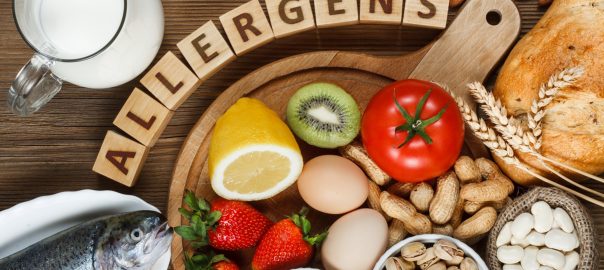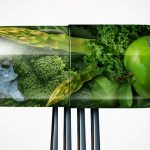
Low Carb Dieting & Allergy Management
Coping with Food Allergies on a Low Carb Diet
Best ways to modify a low carb or ketogenic diet to avoid common allergens.
Food allergies are tricky to manage and require special modifications to get the right dietary nutrients. In this article, we cover the most common food allergens and how to avoid them on a low carb or keto diet, while still getting all the necessary nutrients your body needs.
In Canada, the most common food allergens (in no particular order) are:
- Peanuts
- Tree Nuts (almonds, Brazil nuts, cashews, hazelnuts, macadamia nuts, pecans, pine nuts, pistachios and walnuts)
- Sesame seeds
- Eggs
- Milk
- Mustard
- Soy
- Crustaceans and molluscs
- Fish
- Sulphites (can be found in certain baked goods, frozen foods, cereals, condiments and deli meats)
- Wheat and triticale
While some of these allergens are easier to avoid than others, it is important to know which low carb foods may be harmful to you. To help, we’ve taken each common Canadian allergy and put together a list of foods to avoid and a list of foods to consume while following a low carb or keto diet so your body can still get the best nutrients, safely.
Disclaimer: The information in this article is not medical advice. A low carb diet may not be suitable for you. Consult your health care provider before making any changes to your lifestyle or use at your own risk.
Eggs
Eggs are one of the most nutrient-dense food sources on the planet, rich in several vitamins, minerals and amino acids. While the convenience and simplicity of eggs are hard to beat, there are still many other ways to obtain similar nutrients.
Eggs are high in protein and healthy fats, both of which can also be found in meats and tofu, which are also complete protein sources (meaning they contain all essential amino acids). When choosing animal proteins, be sure to limit processed meats and look for grass-fed, farm-raised and organic where possible. Healthy fats can also be obtained from things like coconuts, olives, avocados, nuts and seeds and fatty fish (salmon, tuna, mackerel and sardines).
Eggs are also rich in iron, vitamins and minerals, which can be obtained alternatively from most dark red and green vegetables, nuts and seeds. Aim to include a serving of fruits or vegetables with every meal and snack during the day. You can also take a daily multivitamin to ensure you are getting the nutrients that your body requires every day.
Finally, eggs are found in a lot of baked goods – which makes them hard to avoid sometimes. They are often used as a binding agent in a lot of recipes. Luckily, vegan bakers figured out numerous ways to substitute eggs and still make delicious, fluffy treats that hold their shape. Instead of an egg, you can combine 1 part flaxseed meal with 3 parts water and let this sit for a few minutes until it forms a gel-like substance. Similarly, you can use ground chia seeds instead of flax; both of these seeds provide a host of nutrients and healthy fats. Some people may also use silken tofu, apple sauce or simply just a ¼ cup of a healthy oil in place of one egg.
Milk
There are several dairy alternatives to choose from. Many plant-based milks and cheeses are made from nuts, soy or oats, and they often taste great! However, these alternatives may not contain as much calcium and vitamin D as milk, unless they have been fortified. But luckily, there are other sources of foods that provide these nutrients, such as soy products, canned fish and dark leafy greens – just be sure to consume some sources of calcium and vitamin D in your day if you don’t eat dairy. Vitamin D is also best obtained from the sun! If you can’t get out during sunlight hours or live in a place where sun exposure is not always available, invest in a vitamin D supplement – they are inexpensive and generally very easy to take (widely available in chewable or liquid drop forms).
Even if you are not allergic to dairy, it is best to avoid it in large amounts. Dairy from cows exposes us to natural hormones found in these animals (that are much larger than the average human) and can increase our risk of developing various chronic diseases. Dairy has also been linked to inflammation, cystic acne, asthma and increased respiratory problems, constipation and digestive problems, and obesity. There are many plant-based alternatives out there that offer similar nutrients and taste great! Plus, they are much easier on the environment!
Mustard
While it’s easy to simply pass on the mustard on your sandwich or burger, be aware that mustard can find its way into many other foods. Things like condiments, salad dressings, spice blends, pickles and other pickled vegetables, and packaged soups can also contain mustard. If you have a mustard allergy, just be sure to double check the ingredients or make these foods from scratch at home. Also, check out our Guide to Pickling Vegetables if you are interested in learning how to make pickled anything from home!
Here is a simple recipe for a low carb homemade salad dressing that you can make at the start of the week and keep in the fridge for later use:
- 3 parts olive, avocado or sunflower oil
- 1 part vinegar
- 1 part citrus juice (low carb)
- Herbs and seasonings such as salt, pepper, oregano, garlic, and onion
Peanuts and Tree Nuts
These allergies have become more common over the last several years, especially in children. If you live in a household with someone who is allergic to peanuts or tree nuts, it is best to avoid keeping these foods in the house as they can trigger or worsen allergic reactions over time.
Unfortunately, a lot of low carb flours, breads, cereals and baked goods can contain nut meals (such as almond meal) as they can emulate much of the same textures and tastes of these foods. That said, there are nut-free alternatives available. Lupin flour, made from lupin beans, is a nut-free and gluten-free low carb alternative to regular flour. It is also high in protein and prebiotic fibre, making it an all-around healthy choice! You could also use or look for products that contain flaxseed meal, ground chia seeds, coconut flour, oat fibre, psyllium husk powder – or a mix of all of these for a well-rounded nutrient profile. Cauliflower is another great option for something like a pizza crust!
Here is a list of nut-free products from our bread and bakery inventory:
- Mama Lupe’s Low Carb Tortillas
- Betty Light Bread
- Chompie’s Breads available in Sesame and Multigrain
- Flatout Flatbreads
- Nuco Organic Coconut Wraps (*coconut is sometimes considered a tree nut, but it is actually classified as a fruit and most people with tree nut allergies can still safely eat coconuts).
These cereals also contain no nuts or traces of nuts:
- Catalina Crunch Keto-Friendly Breakfast Cereals
- Nuco Coconut Crunch Cereal
Sesame Seeds
Sesame seeds are another sneaky allergen, as they can find their way into several bakery items, cereals and crackers. Some of these products in the nut-free category are also sesame-free including: Mama Lupe’s Low Carb Tortillas, Betty Light Bread (*may contain traces of sesame), Flatout Flatbreads and Nuco Organic Coconut Wraps.
Some other sesame-free products we carry include:
- Carbonaut Breads, Hamburger Buns (Gluten-Free Option) , and Hot Dog Buns (Gluten-Free Option)
- Fresh Betty Light Bread
- ThinSlim Desserts and Snacks
- KZ Clean Eating Breakfast Cereals (*may contain traces of sesame)
- GluteNull Granolas
- HoldTheCarbs Granolas
- Fat Snax
- Eve’s Crackers (except Black Sesame flavour)
- BeyondChipz
- HighKey Foods
- Hu
- Swedish Protein Deli
Soy
This is a big allergy that can be found in a wide range of products. Aside from the obvious soybeans, tofu and edamame – soy can be found in baked goods, canned soups and meat, cereals, cookies, crackers, energy bars and snacks and protein supplements. Soy protein isolate is also a common food preservative in many frozen foods.
If you are looking for soy-free low carb snack foods, opt for things that are nut or seed-based instead. KZ Clean Eating Crispbreads are a great soy-free option that can be enjoyed with cheese, nut butter, avocado and other spreads and dips!
If you are looking for protein supplements, try whey or egg white protein. Collagen is another common choice for keto dieters, and especially those wanting to improve the look of skin, nails and hair.
We sell these soy-free, low carb and keto-friendly protein bars:
Fish and Shellfish
Fish and shellfish are some of the best sources of omega-3 fatty acids, especially DHA and EPA. These nutrients are extremely important for healthy brain, heart and immune function. Many people do not get enough omega-3 fatty acids in their diet, and if fish and shellfish are off-limits for you, it can be harder to get these important nutrients from other foods.
If you don’t eat fish and shellfish, your best option for getting DHA and EPA is supplements made from microalgae, which is the ultimate source from which fish and shellfish get these nutrients. Plant sources of omega-3 fatty acids include walnuts, chia seeds, hempseeds, flaxseeds and flaxseed oil, leafy vegetables and soybean oils. However, these primarily contain a different type of omega-3 fatty acids, ALA, which gets converted into DHA and EPA – but not as efficiently. That said, they are still great sources of other important nutrients. Try making a salad with leafy greens, nuts, seeds and drizzle with flaxseed oil and citrus juice!
It is also important to limit your intake of omega-6 fatty acids, especially if you are already not getting enough omega-3 fatty acids in your diet. Omega-6 fatty acids are a necessary part of the diet, but in excess, they can cause inflammation, raise blood pressure (increasing risk for heart complications) and cause your body to retain too much water. The worst culprits of omega-6 fatty acids are vegetable and seed oils (corn, canola, safflower, sunflower, peanut and sesame seed oils) – especially those used in frying fast foods – as well as things like margarine and shortening. They are also found in poultry, nuts and eggs, although in much smaller quantities. To limit your intake of omega-6 fatty acids, try to avoid restaurant-cooked foods, packaged snacks and baked goods and other junk foods and be sure to eat a balanced diet containing other sources of omega-3 fatty acids.
Sulphites
Sulphites are substances that naturally occur in some foods, but they are also used as food additives and preservatives. This is why they are commonly found in packaged and frozen food products (especially anything with dried fruits), deli meats, hot dogs, sausages, certain condiments, dehydrated foods, soy products and alcoholic beverages. For some people, consuming sulphites can cause severe anaphylactic and asthmatic reactions. Others with milder sensitivity to sulphites can experience other types of reactions such as upset stomach, migraines and headaches, hives, drop in blood pressure and trouble swallowing or breathing.
If you have a sulphite sensitivity, always check the ingredients lists before buying foods, avoid packaged foods and ask about any sulphite-containing foods at restaurants.
Wheat and Triticale
Finally, wheat and triticale (hybrid of wheat and rye) close off our list of common allergens in Canada. Note that a wheat allergy is not the same as a gluten allergy or celiac disease, as gluten may not be the main culprit in the case of a wheat allergy. Nonetheless, they can be treated by avoiding similar foods and often involve the same symptoms such as bloating, abdominal pain, gas and diarrhea. Celiac disease is a more serious medical condition in which the immune system attacks gluten (a protein primarily found in wheat, rye and barley) and causes damage to the lining of the intestines.
If you want to avoid wheat and/or gluten, there are still many other grains that you can enjoy such as quinoa, oats, brown and wild rice, buckwheat, tapioca, millet, amaranth, teff, and arrowroot. That said, if you follow a low carb diet, avoiding things like wheat and triticale becomes that much easier! Just be sure to double check ingredient labels as some low carb products can still contain small amounts of wheat used to emulate the original taste and texture of things like bread and pastries. Also be sure to check the ingredients of sauces, processed meats and frozen foods as they could contain traces or have come in contact with wheat during processing. On our website, you can look for the purple Gluten-Free marker on our products if you have a gluten intolerance!
Stay Connected
We hope that you found this guide useful for managing allergies while on a low carb diet. If you would like to share your thoughts or experiences, head over to our Facebook and Instagram pages. We also love to read and respond to our reviews on Google, so please share any experience you’ve had with us over there!
Also, be sure to subscribe to our weekly newsletters for special updates on the latest products and to find the best low carb sales!






